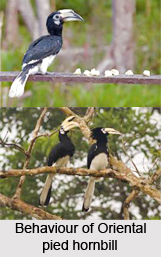 Oriental Pied Hornbill is an Indian bird and it belonged from the India- Malayasian species.
Oriental Pied Hornbill is an Indian bird and it belonged from the India- Malayasian species.
Category of Oriental Pied Hornbill
Oriental Pied Hornbill has the two other common names for this species that are sunda pied hornbill (convexus) and Malaysian pied hornbill. The species is considered to be among the smallest and most common of the Asian hornbills.
Distribution of Oriental Pied Hornbill
Oriental Pied Hornbill has the largest distribution in the genus and is found in the Indian Subcontinent and throughout Southeast Asia. Its natural habitat is subtropical or tropical moist lowland forests. The oriental pied hornbill`s diet includes fruit, insects and small reptiles.
Species of Oriental Pied Hornbill
Oriental Hornbill, of the family Bucerotidae, belongs to the genus Anthracoceros, which consists of five species. Species in this genus are divided into two groups, Indo-malayan pied hornbills and black hornbills. A. Albirostris is grouped under the Indo-Malayan pied hornbills, based on plumage similarities, along with the Indian pied hornbill (A. coronatus) and the Palawan hornbill (A. marchei). The black hornbills include A. Malayanus and A. Montani. A. Albirostris can be further categorized into two subspecies, A. A. Albirostris and A. A. Convexus.
Structure of Oriental Pied Hornbill
Oriental Pied Hornbill is a medium size frugivore with a head-to-tail length of 55-60 cm from head to tail and a wingspan of 23-36 cm. The bill measures 19 cm for males and 16 cm for females. It can weigh between 600 g and 1,050 g, averaging 900 g for males and 875 g for females. The plumage of the head, neck, back, wings and upper breast is black with a slight green sheen. The tail is black with white tips on all the feathers except the central feathers (rectories).
Plumage of Oriental Pied Hornbill
The plumage of the lower breast, lower abdomen, thighs, under-wing and all the tips of the wings except the three basal secondaries and two outer primaries is white, as is the circumorbital skin around the eyes and on the throat skin. A blue tinge can sometimes be noticed on the throat of adults. Casques of mature A. Albirostri are laterally flattened "Cylinders", which may form a protruding horn.
Adults of Oriental Pied Hornbill
The males and females of Oriental Pied Hornbill are similar in coloration. Males can be distinguished from females by their larger body size, yellow bill, which has a black base, and bright red eyes. Females have a slightly smaller body size, a yellow bill and casque with a partly black, browned patched mandible, and greyish-brown eyes. Juvenile A. Albirostris resemble the adults, but have an undeveloped casque and a smaller bill. Their black plumage lacks the green gloss found on adults.
Call of Oriental Pied Hornbill
The calls of Oriental Pied Hornbill have been described as crow-like sounds, braying sounds or harsh crackles and screeches.
 Nests of Oriental Pied Hornbill
Nests of Oriental Pied Hornbill
Oriental Pied Hornbill is found in the Indian Subcontinent and Southeast Asia, ranging across Bangladesh, Bhutan, Brunei, Cambodia, Eastern and Northern India, Indonesia, Laos, North peninsular Malaysia, Myanmar, Nepal, Singapore, Thailand, Tibet, Vietnam and the Sunda shelf islands. Its natural habitat is subtropical or tropical moist lowland forests. Within these regions, A. Albirostris occupies various habitat types, which include dry and semi-evergreen forests, dry and moist deciduous forests, subtropical broadleaf forests, secondary forests, plantations and woodlands.
Diet of Oriental Pied Hornbill
Oriental Pied Hornbills are predominantly frugivores. The oriental pied hornbill`s diet consists of wild fruits such as figs (Ficus spp.), melanoxylon berries, rambutans, palm fruit, papaya and fruits of liana plants. It will also take large insects (grasshoppers), small birds (finches) small reptiles (lizards and snakes), amphibians such as frogs, and fish. Its diet differs slightly between the breeding and non-breeding season. During the non-breeding season, oriental pied hornbills feed more on non-fig fruit such as small sized berries, drupes, arillate capsules and lianas (woody vines), however the availability of these food items is lower in the breeding season, which suggests that the species increases its habitat range during that time. They also tend to feed in flocks during the non breeding season. When foraging for food, they tend to select a few common species of fruit trees.



















